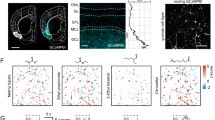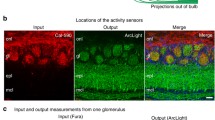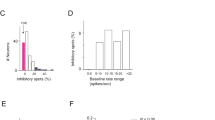Abstract
Contrast enhancement via lateral inhibitory circuits is a common mechanism in sensory systems. We here employ a computational model to show that, in addition to shaping experimentally observed molecular receptive fields in the olfactory bulb, functionally lateral inhibitory circuits can also mediate the elemental and configurational properties of odor mixture perception. To the extent that odor perception can be predicted by slow-timescale neural activation patterns in the olfactory bulb, and to the extent that interglomerular inhibitory projections map onto a space of odorant similarity, the model shows that these inhibitory processes in the olfactory bulb suffice to generate the behaviorally observed inverse relationship between two odorants' perceptual similarities and the perceptual similarities between either of these same odorants and their binary mixture.
Similar content being viewed by others
References
Buonviso N, Chaput MA (1990) Response similarity to odors in olfactory bulb output cells presumed to be connected to the same glomerulus: Electrophysiological study using simultaneous single-unit recordings. J. Neurophysiol. 63: 447-454.
Cleland TA, Morse A, Yue EL, Linster C (2002) Behavioral models of odor similarity. Behav. Neurosci. 116: 222-231.
Cleland TA, Linster C (1999) Concentration tuning mediated by spare receptor capacity in olfactory sensory neurons: A theoretical study. Neural. Comput. 11: 1673-1690.
Derby CD, Hutson M, Livermore BA, Lynn WH (1996) Generalization among related complex odorant mixtures and their components: Analysis of olfactory perception in the spiny lobster. Physiol. Behav. 60: 87-95.
Duchamp-Viret P, Duchamp A, Chaput M (1993) GABAergic control of odor-induced activity in the frog olfactory bulb: Electrophysiological study with picrotoxin and bicuculline. Neuroscience 53: 111-120.
Ennis M, Linster C, Aroniadou-Anderjaska V, Ciombor K, Shipley MT (1998) Glutamate and synaptic plasticity at mammalian primary olfactory synapses. Ann. NY Acad. Sci. 855: 457-466.
Galizia CG, Menzel R (2000) Odour perception in honeybees: Coding information in glomerular patterns. Curr. Opin. Neurobiol. 10: 504-510.
Hirsch JA, Martinez LM, Alonso JM, Desai K, Pillai C, Pierre C (2002) Synaptic physiology of the flow of information in the cat's visual cortex in vivo. J. Physiol. 540: 335-350.
Jinks A, Laing DG (1999) A limit in the processing of components in odour mixtures. Perception. 28: 395-404.
Johnson BA, Leon M (2000a) Modular representations of odorants in the glomerular layer of the rat olfactory bulb and the effects of stimulus concentration [see comments]. J. Comp. Neurol. 422: 496-509.
Johnson BA, Leon M (2000b) Odorant molecular length: One aspect of the olfactory code. J. Comp. Neurol. 426: 330-338.
Johnson BA, Woo CC, Hingco EE, Pham KL, Leon M (1999) Multidimensional chemotopic responses to n-aliphatic acid odorants in the rat olfactory bulb. J. Comp. Neurol. 409: 529-548.
Kay LM, Lowry CA, Jacobs HA (2003) Receptor contributions to configural and elemental odor mixture perception. Behav. Neurosci. 117(5): 1108-1114.
Kosaka K, Toida K, Aika Y, Kosaka T (1998) How simple is the organization of the olfactory glomerulus?: The heterogeneity of so-called periglomerular cells. Neurosci. Res. 30: 101-110.
Laing DG (1987) Coding of chemosensory stimulus mixtures. Ann. NY Acad. Sci. 510: 61-66.
Laing DG, Eddy A, Best DJ (1994) Perceptual characteristics of binary, trinary, and quaternary odor mixtures consisting of unpleasant constituents. Physiol. Behav. 56: 81-93.
Laing DG, Francis GW (1989) The capacity of humans to identify odors in mixtures. Physiol. Behav. 46: 809-814.
Laing DG, Panhuber H, Slotnick BM (1989) Odor masking in the rat. Physiol. Behav. 45: 689-694.
Laing DG, Panhuber H, Willcox ME, Pittman EA (1984) Quality and intensity of binary odor mixtures. Physiol. Behav. 33: 309-319.
Laing DG, Willcox ME (1987) An investigation of the mechanisms of odor suppression using physical and dichorhinic mixtures. Behav. Brain Res. 26: 79-87.
Laska M, Hudson R (1993) Discriminating parts from the whole: Determinants of odor mixture perception in squirrel monkeys, Saimiri sciureus. J. Comp. Physiol. [A] 173: 249-256.
Leon M, Johnson BA (2003) Olfactory coding in the mammalian olfactory bulb. Brain Res. Brain Res. Rev. 42: 23-32.
Linster C, Cleland TA (2002) Cholinergic modulation of sensory representations in the olfactory bulb. Neural. Netw. 15: 709-717.
Linster C, Garcia PA, Hasselmo ME, Baxter MG (2001a) Selective loss of cholinergic neurons projecting to the olfactory system increases perceptual generalization between similar, but not dissimilar, odorants. Behav. Neurosci. 115: 826-833.
Linster C, Gervais R (1996) Investigation of the role of interneurons and their modulation by centrifugal fibers in a neural model of the olfactory bulb. J. Comput. Neurosci. 3: 225-246.
Linster C, Hasselmo M (1997) Modulation of inhibition in a model of olfactory bulb reduces overlap in the neural representation of olfactory stimuli. Behav. Brain. Res. 84: 117-127.
Linster C, Hasselmo ME (1999) Behavioral responses to aliphatic aldehydes can be predicted from known electrophysiological responses of mitral cells in the olfactory bulb. Physiol. Behav. 66: 497-502.
Linster C, Johnson BA, Morse A, Yue E, Leon M (2002) Spontaneous versus reinforced olfactory discriminations. J. Neurosci. 22: 6842-6845.
Linster C, Johnson BA, Yue E, Morse A, Xu Z, Hingco EE, Choi Y, Choi M, Messiha A, Leon M (2001b) Perceptual correlates of neural representations evoked by odorant enantiomers. J. Neurosci. 21: 9837-9843.
Linster C, Smith BH (1999) Generalization between binary odor mixtures and their components in the rat. Physiol. Behav. 66: 701-707.
Luo M, Katz LC (2001) Response correlation maps of neurons in the mammalian olfactory bulb. Neuron. 32: 1165-1179.
Meister M, Bonhoeffer T (2001) Tuning and topography in an odor map on the rat olfactory bulb. J. Neurosci. 21: 1351-1360.
Meredith M (1986) Patterned response to odor in mammalian olfactory bulb: The influence of intensity. J. Neurophysiol. 56: 572-597.
Mori K, Nagao H, Sasaki YF (1998) Computation of molecular information in mammalian olfactory systems. Network. 9: R79-R102.
Mori K, Nagao H, Yoshihara Y (1999) The olfactory bulb: Coding and processing of odor molecule information. Science 286: 711-715.
Pinching AJ, Powell TP (1971a) The neuron types of the glomerular layer of the olfactory bulb. J. Cell. Sci. 9: 305-345.
Pinching AJ, Powell TP (1971b) The neuropil of the glomeruli of the olfactory bulb. J. Cell. Sci. 9: 347-377.
Pinching AJ, Powell TP (1971c) The neuropil of the periglomerular region of the olfactory bulb. J. Cell. Sci. 9: 379-409.
Rubin BD, Katz LC (1999) Optical imaging of odorant representations in the mammalian olfactory bulb. Neuron. 23: 499-511.
Sachse S, Galizia CG (2002) Role of inhibition for temporal and spatial odor representation in olfactory output neurons: A calcium imaging study. J. Neurophysiol. 87: 1106-1117.
Schreiner CE, Read HL, Sutter ML (2000) Modular organization of frequency integration in primary auditory cortex. Annu. Rev. Neurosci. 23: 501-529.
Scott JW, Wellis DP, Riggott MJ, Buonviso N (1993) Functional organization of the main olfactory bulb. Microsc. Res. Tech. 24: 142-156.
Shepherd GM (1985) The olfactory system: The uses of neural space for a non-spatial modality. Prog. Clin. Biol. Res. 176: 99-114.
Shipley MT, Ennis M (1996) Functional organization of olfactory system. J. Neurobiol. 30: 123-176.
Smith BH (1996) The role of attention in learning about odorants. Biol. Bull. 191: 76-83.
Smith BH (1998) Analysis of interaction in binary odorant mixtures. Physiol. Behav. 65: 397-407.
Smith TC, Jahr CE (2002) Self-inhibition of olfactory bulb neurons. Nat. Neurosci. 5: 760-766.
Staubli U, Fraser D, Faraday R, Lynch G (1987) Olfaction and the "data" memory system in rats. Behav. Neurosci. 101: 757-765.
Sutter ML, Schreiner CE, McLean M, O'Connor KN, Loftus WC (1999) Organization of inhibitory frequency receptive fields in cat primary auditory cortex. J. Neurophysiol. 82: 2358-2371.
Uchida N, Takahashi YK, Tanifuji M, Mori K (2000) Odor maps in the mammalian olfactory bulb: Domain organization and odorant structural features. Nat. Neurosci. 3: 1035-1043.
Urban NN (2002) Lateral inhibition in the olfactory bulb and in olfaction. Physiol. Behav. 77: 607-612.
Wiltrout C, Dogra A, Linster C (2003) Configurational and nonconfigurational interactions in binary olfactory mixtures. Behavioral Neuroscience 117: 236-245.
Xing J, Gerstein GL (1994) Simulation of dynamic receptive fields in primary visual cortex. Vision Res. 34: 1901-1911.
Xing J, Gerstein GL (1996) Networks with lateral connectivity. I. dynamic properties mediated by the balance of intrinsic excitation and inhibition. J. Neurophysiol. 75: 184-199.
Yokoi M, Mori K, Nakanishi S (1995) Refinement of odor molecule tuning by dendrodendritic synaptic inhibition in the olfactory bulb. Proc. Natl. Acad. Sci. USA 92: 3371-3375.
Author information
Authors and Affiliations
Rights and permissions
About this article
Cite this article
Linster, C., Cleland, T.A. Configurational and Elemental Odor Mixture Perception Can Arise from Local Inhibition. J Comput Neurosci 16, 39–47 (2004). https://doi.org/10.1023/B:JCNS.0000004840.87570.2e
Issue Date:
DOI: https://doi.org/10.1023/B:JCNS.0000004840.87570.2e




